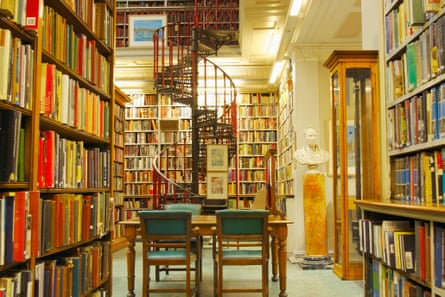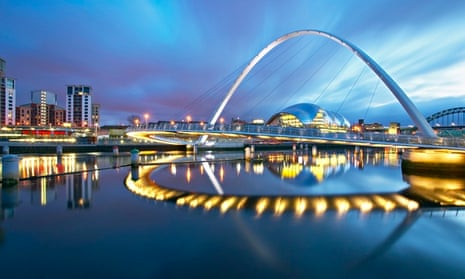One February night a few years ago I found myself standing on the bank of a wide, dark river. Pastel-coloured lights melted across the glossy surface of the water. The rainbow arch of one great bridge was echoed downstream by the blue-green span of another. The glass of great buildings glimmered and a cool wind blew from the east. I felt as I had in other great cities at night - as if I was in a timeless and magical place. It took me some while to reconcile this with the knowledge that I was in Newcastle.
I say this not from lofty metropolitan disdain. Newcastle is the nearest city to where I was born, the nearest city to where I live now. I have been visiting it for long enough to remember when it looked like it does in the film Get Carter – all brick, slate and smoke. I have come here to watch football and see bands, to eat and drink, and to shop for goods from Airfix kits years ago to prams and pushchairs more recently. But until that winter evening I had never really noticed Newcastle. Familiarity had bred indifference. It was like that moment in a corny Hollywood movie when the frumpy girl next door takes off her glasses and – aw, gee! – it’s Grace Kelly!
That Newcastle has been voted the best UK city by readers of the Guardian and Observer therefore comes as little surprise. Certainly no local will do a double take on hearing the news. Indeed the fact the city was only ranked fifth last year is more likely to register as a shock. You see, Newcastle’s atmosphere of almost pathological friendliness and good humour stems from one simple thing: all Geordies believe themselves blessed to have been born here. Theirs is the boisterous self-confidence of a chosen people.

Newcastle is noted as a party city. On Saturdays, hen and stag dos roll in from early morning. When the Test Match is being played at Chester-le-Street as well, it’s not uncommon to find yourself the only person in the splendidly restored Central Station who isn’t wearing a sombrero or a Superhero outfit. But you don’t have to wear a pink cowboy hat, a T-shirt with your nickname on your back, or a PVC nurse’s outfit to enjoy yourself in the city.
Newcastle is founded on innovation and engineering. You get a good sense of its Victorian heyday at the Literary and Philosophical Society, a short walk from the station with its neo-classical frontage. Started in 1793 as a “conversation club, the Lit & Phil is a private library with the feel of a Pall Mall club. Oscar Wilde and Edith Sitwell have lectured there, and comedian Alexander Armstrong is current president. Only members can take books out, but the public are free to wander in, sit in a leather armchair, buy a cup of tea and biscuit from the hatch and read the periodicals while admiring the burnished wood interiors.
Traditional pubs were once almost obliterated on Tyneside by the vogue for high-turnover drinking houses with flashing lights, fizzy lager and booming music. At one point it seemed like only the redoubtable Crown Posada on The Side was keeping the notion of a quiet pint of ale alive. Not any more. There’s a thriving micro-brewery culture across Tyneside, County Durham and Northumberland these days and plenty of places to try them. The Cumberland Arms in James Place Street, Ouseburn, has pickled onions, pork pies, excellent real ale from local breweries such as Northern Alchemy and Allendale. Nearby in St Lawrence Road is the equally fine Free Trade Inn: watch the sun setting behind the Tyne Bridge from its front garden for a touch of true northern romance.

The Baltic Centre for Contemporary Art, on the south side of the river in Gateshead, has an outpost in High Bridge, Baltic 39, with changing exhibitions and events in its top-floor project gallery. It put on the original version of the critically acclaimed They Used to Call it the Moon exhibition, which has now moved to the bigger space over the Tyne.
Twenty years ago decent places to eat were thin on the ground. That’s no longer the case. The Settle Down Cafe on Thornton Street has a back room like the parlour of your nan’s house. The food is good too, particularly the cakes (which you can buy to take away at the Sugar Down Bakery, round the corner in Pink Lane, a narrow alley that is also home to the excellent Pink Lane Coffee) and the service is notably friendly even by Newcastle standards. The Sugar Down supplies bread to another burgeoning new institution, Quilliam Brothers Tea House, which is in a baronial Victorian building behind the university that once housed a bookshop. The Quilliams import the tea themselves, in around 60 varieties, and they’ve recently opened a cinema in the basement. Fittingly, Newcastle’s splendid art-deco cinema, The Tyneside also has several good cafes.
The restaurant scene is also undergoing a renaissance, with Michelin-star chasing House of Tides and real ale and sourdough pizza joint DAT Bar joining Terence Laybourne’s tweedy gastro-pub The Broad Chare and old-school family- friendly Sardinian Panis among the local favourites.
One final tip: Geordies like to talk. Visitors are advised to allow at least 10 minutes just to buy a newspaper.

Comments (…)
Sign in or create your Guardian account to join the discussion